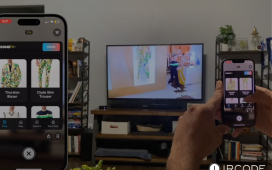
Concerns are mounting over the potential slowdown in global smartphone shipments, triggered by US President Donald Trump’s escalating tariff policies, which may in turn dampen the growth momentum of Korea’s OLED display industry.
According to market tracker Counterpoint Research on Monday, the global smartphone shipment growth forecast for this year has been revised down from 4.2 percent to 1.9 percent. The downgrade was attributed to new uncertainties surrounding US tariffs, the report said.
Apple, the single largest buyer in the OLED market, remains at the center of attention as Korean panel suppliers closely monitor the unfolding trade developments.
Another research firm, Omdia, also lowered its forecast for smartphone panel market growth, from 5 percent to 4 percent, citing weakening demand. Smartphone displays, which account for the largest share of the overall display market, are expected to see declining revenues.
Market watchers warn that if tariffs are imposed on finished products such as smartphones, it could lead to higher retail prices and dampened consumer demand, and possibly force smartphone makers to pass the burden down to their suppliers.
Currently, it is estimated that Samsung Display supplies about half of OLED panels for iPhones, followed by LG Display with 30 percent and China’s BOE with 20 percent. For premium models such as the iPhone Pro, Korean firms are believed to be the sole suppliers.
“Should the Trump administration implement tariffs on smartphones, device manufacturers are likely to consider price hikes and component cost reductions to offset the impact,” said Im Mi-hye, a senior researcher at the Korea Eximbank’s Overseas Economic Research Institute.
“Display makers will need to further intensify cost-cutting efforts to stay competitive.”
Meanwhile, Chinese panel makers — less reliant on Apple — are expected to continue expanding their market share by catering primarily to local smartphone brands.
Despite the overall market downgrade, Counterpoint Research forecasted Huawei’s shipments to rise by 11 percent this year, saying that supply bottlenecks for key components are expected to ease by year-end, allowing Huawei to secure a solid foothold in China’s mid- to low-end market.
The TV OLED segment, where Korean companies hold a production monopoly, is also facing headwinds. In the first quarter of this year, average selling prices of OLED TV panels fell by 5 to 9 percent compared to a year ago, continuing a downward trend that began in the third quarter of 2023.
“In the short term, the US tariff policy may have a limited impact on Korea’s display industry,” said an industry source who requested anonymity. “However, in the long term, fears of inflation and global economic slowdown are likely to dampen demand for IT devices — and with it, the demand and pricing power for displays as well.”
yeeun@heraldcorp.com









